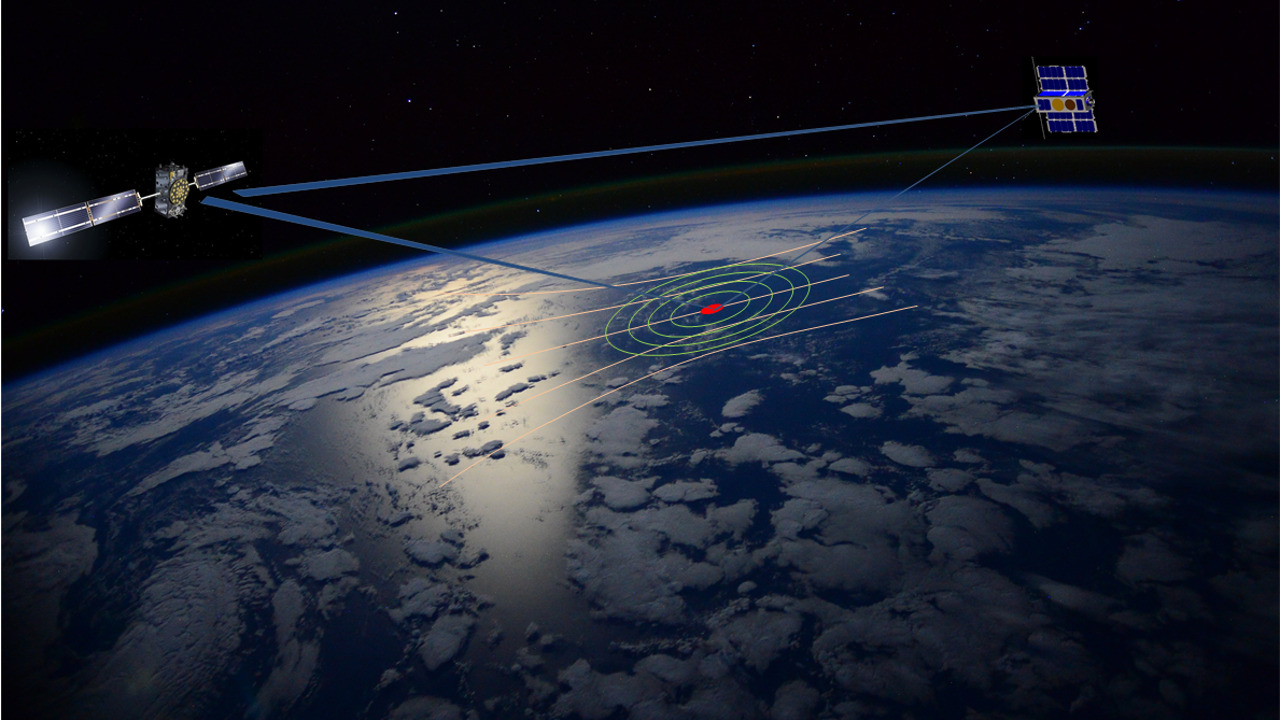ESA’s PRETTY mission is in orbit
- The mission of the European Space Agency (ESA) will develop altimetry techniques that will allow a precise measurement of the topography of the sea and ice from space
- IEEC researchers at the Institute of Space Sciences (ICE-CSIC) will work with the first results of the mission
- The study of the marine surface will foster scientific research and social progress in areas such as climate, fisheries management or cyclone prediction

Llegenda: PRETTY is testing slant reflectometry.
Crèdits: ESA
Last 9 October 2023, the European Space Agency (ESA)’s PRETTY mission was launched into space aboard the Vega rocket from French Guiana in order to capture satellite navigation signals (GNSS). A team from the Institute of Space Sciences (ICE-CSIC) and the Institute of Space Studies of Catalonia (IEEC) participates in the scientific consortium of this nanosatellite that will test innovative and cost-effective ways to monitor sea and ice surface levels from space.
The PRETTY (Passive REflecTometry and dosimeTrY) is a CubeSat 3U nanosatellite, a miniature cuboidal-shaped satellite, equipped with a pair of forward-facing antennas to capture signals from navigation satellites close to the horizon. The antenna on its forward face will pick up the signal from a GNSS satellite that travels through two ray-paths: a direct path directly from the GNSS and a path that has first bounced off the Earth’s cryosphere or the oceans. By innovative processing and analysis of these signals, the mission aims to demonstrate that the technique can derive ice and sea height to an accuracy of at least 50 cm from 550 km orbital altitude.
GNSS signals reflected in the sea make it possible to accurately measure the topography of the sea at very low angles. The Earth Observation research group of the IEEC at the ICE-CSIC, led by Dr Estel Cardellach, including researchers Serni Ribó and Weiqiang Li, has been developing altimetry techniques based on GNSS signals since the end of the 1990s. The team participates in the scientific consortium coordinated by the Norwegian University of Science and Technology (NTNU) in partnership with the GFZ German Research Centre for Geosciences and German Aerospace Center (DLR-SO).
The ICE-CSIC and IEEC team has helped defining parameters of the GNSS receiver onboard, and will be in charge, together with DLR-SO and GFZ, of generating the first altimetric solutions from PRETTY’s collected signals during the initial phases of the satellite mission.
Launch of PRETTY
More on grazing angle altimetry
“In PRETTY, we will try to demonstrate different aspects of GNSS altimetry at very low angles. It is a technique with great potential but it also presents complicated challenges,” says Cardellach. “In our group, we have the responsibility of providing the first altimetric results during the initial phases after the launch,” she adds.
Exploring the shape of the sea surface, its height and the processes that alter it will allow better applications at a scientific and social level in climate research, ocean currents prediction, cyclones prediction, fisheries management, monitoring of debris and plastics, etc.
Press release prepared in collaboration with the Institute of Space Sciences (ICE-CSIC).
Contacts
IEEC Communication Office
Barcelona, Spain
E-mail: comunicacio@ieec.cat
Lead Researcher at the IEEC
Barcelona, Spain
Estel Cardellach
Institute of Space Studies of Catalonia (IEEC)
Institute of Space Sciences (ICE-CSIC)
E-mail: estel@ieec.cat
About the IEEC
The Institute of Space Studies of Catalonia (IEEC — Institut d’Estudis Espacials de Catalunya) promotes and coordinates space research and technology development in Catalonia for the benefit of society. IEEC fosters collaborations both locally and worldwide and is an efficient agent of knowledge, innovation and technology transfer. As a result of more than 25 years of high-quality research, done in collaboration with major international organisations, IEEC ranks among the best international research centres, focusing on areas such as: astrophysics, cosmology, planetary science, and Earth Observation. IEEC’s engineering division develops instrumentation for ground- and space-based projects, and has extensive experience in working with private or public organisations from the aerospace and other innovation sectors.
The IEEC is a non-profit public sector foundation that was established in February 1996. It has a Board of Trustees composed of the Generalitat de Catalunya, Universitat de Barcelona (UB), Universitat Autònoma de Barcelona (UAB), Universitat Politècnica de Catalunya · BarcelonaTech (UPC), and the Spanish Research Council (CSIC). The IEEC is also a CERCA centre.
